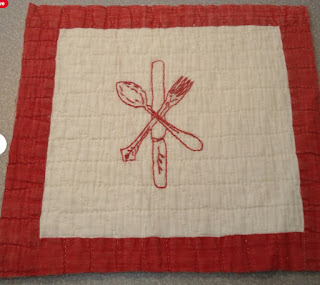Quilt blocks as messages to hoboes.
Historian Report: The Use of Quilt Designs to Communicate with Hoboes
Introduction:
Throughout history, communication has taken many forms, adapting to the needs and circumstances of different groups of people. One fascinating example of this is the use of quilt designs as a means of communication with hoboes during the late 19th and early 20th centuries. In this report, we will explore the origins, purpose, and significance of this unique form of communication.
Origins of Quilt Designs as Communication:
The use of quilt designs as a means of communication with hoboes, commonly referred to as "hobo code," is believed to have emerged in the United States during the time of the Great Depression. During this period, many individuals found themselves traveling across the country in search of employment and sustenance. To navigate the challenges they faced, hoboes developed a system of symbols and signs that could be understood by their fellow travelers.
Purpose and Function:
The primary purpose of the quilt designs used by hoboes was to convey information and warnings about the local environment, allowing fellow travelers to navigate their way safely throughout their journeys. These designs were typically displayed on fences, walls, or even the back of doors, serving as a visual language understood by those within the hobo community.
Quilt Design Symbolism:
The quilt designs employed in hobo code were composed of various geometric shapes and figures, each representing a specific message or instruction. Here are some examples of common symbols and their meanings:
1. A Double Cross: Indicates a dangerous or hostile area to be avoided.
2. A Cat: Warns of an unfriendly or hostile homeowner.
3. A Circle with a Dot: Signifies that the location is a good place to find food.
4. A Triangle: Indicates that the area supports the hobo code and is open to their presence.
5. Zigzag Lines: Signals that a change of direction or route is required to avoid obstacles or danger.
6. A Crossed Knife and Spoon: Suggests that the location provides both food and work opportunities.
The Significance of Quilt Designs for Hoboes:
The use of quilt designs as a communication tool for hoboes held great significance as it provided a means of survival and support within a transient community. The coded messages allowed hoboes to share vital information about their surroundings, reducing risks and increasing opportunities for finding food, shelter, and employment.
Legacy and Recognition:
Although the hobo code and its quilt designs were primarily used during the Great Depression era, their significance as a unique form of communication has not been forgotten. In recent years, efforts have been made to preserve and recognize this aspect of history. Organizations and individuals have documented the various symbols used in hobo code, ensuring that this unconventional method of communication is not lost to time.
Conclusion:
The use of quilt designs as a communication tool by hoboes during the Great Depression era was a remarkable means of conveying messages, warnings, and information within their transient community. These symbolic designs not only provided practical assistance in navigating their journeys but also fostered a sense of shared identity and belonging among a marginalized group. The quilt designs used by hoboes remain a fascinating aspect of history, showcasing the ingenuity and resourcefulness that can emerge even in the most challenging times.



Comments
Post a Comment